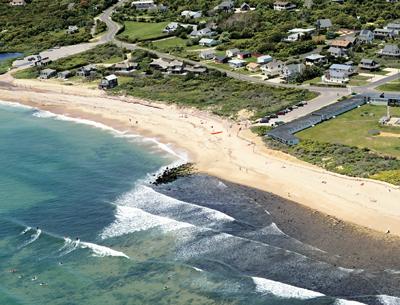Sand Coming to Replenish Ditch Plain

Sand will be trucked in to Ditch Plain Beach in Montauk to create a soft beach on top of a stretch of hardpan that has been exposed by severe erosion, leading East Hampton Town to hold off on posting lifeguards at the popular site and keep it closed as a bathing beach.
Following pleas by Montauk residents to actively address the situation, which officials had hoped would improve due to a normal seasonal accretion of sand onto that beach, town board members voted last Thursday to seek bids from contractors to perform the work. Bids may be submitted to the town purchasing agent, who can provide specifications, until 11 a.m. on Wednesday.
Supervisor Bill Wilkinson said at a board work session on Tuesday that he had hand-carried a permit application for the work to State Department of Environmental Conservation offices, seeking an expedited go-ahead.
John McGeehan, the town’s assistant chief of lifeguards, who oversees the Montauk beaches, told the board at that meeting that some sand from offshore had been “filling in” the beach, but recent heavy rains had taken a toll. “I’m glad it wasn’t authorized in the last week and a half,” he said of trucking new sand in. “Because on two occasions, that sand would be gone.”
The fix is an “emergency plan” for the summer season, said Councilman Dominick Stanzione. “We recognize that the action that we take may have no permanence — that the sand we place may not last,” he said. Plans for longer-term fixes, such as the Army Corps of Engineers’ design for an engineered, reconstructed downtown Montauk beach, are also underway, the councilman said.
Mr. Wilkinson said that, pending D.E.C. approval, the trucked-in sand would be placed in an area east of the traditional bathing beach adjacent to the main Ditch Plain parking lot, closer to Otis Road.
The beach there, he said, seems to be “holding.” While normally, a lifeguard stand would be placed in that area as well as on the westerly beach, this year, both would be set up on the fortified stretch of sand.
“The erosion down there, as of this morning, is the worst we’ve seen this spring,” reported Mr. McGeehan, who had visited Ditch before attending the meeting. More hardpan was being exposed at the easterly site, he said. “If this pattern continues that we’re seeing right now, we would literally have to put the [lifeguard] stands on the beach in the morning, and remove them in the evening,” to prevent them from being washed away. Had they been in place on Monday night, he said, they would have been lost. The lifeguard stand at Edison Beach in downtown Montauk, he said, where water flowed through a dead-end road end at the beach, was almost washed away during the same rainstorm.
Mr. McGeehan said that the protected bathing beach, if set up at the Otis Road area of Ditch, would be “squeezed.”
“We can’t go too far east,” he said, “because at the jetty is a significant rip. It is the most challenging beach to protect swimmers in the Town of East Hampton,” he said.
One thing that is less of a concern, the lifeguard said, is the threat of submerged objects in the surf. With other lifeguards, he went into the ocean off Ditch and found sand — though whether that is true all along that stretch cannot be verified.
However, he said, showing the board a metal fencing stake used to erect sand fencing along the beach, “on a typical day we will have at least 10 to 15 of these brought to us” by people fishing them out of the water. They become buried in sand and then reappear at the shorebreak, he said. Lifeguards have also been removing numbers of them from the sand, Mr. McGeehan said, expressing concern that, along Montauk’s downtown “Motel Row,” 300 to 400 new stakes are going in to support fencing being erected by private and commercial property owners. The town code, which requires permits for sand fencing, allows only the use of untreated wooden stakes.
